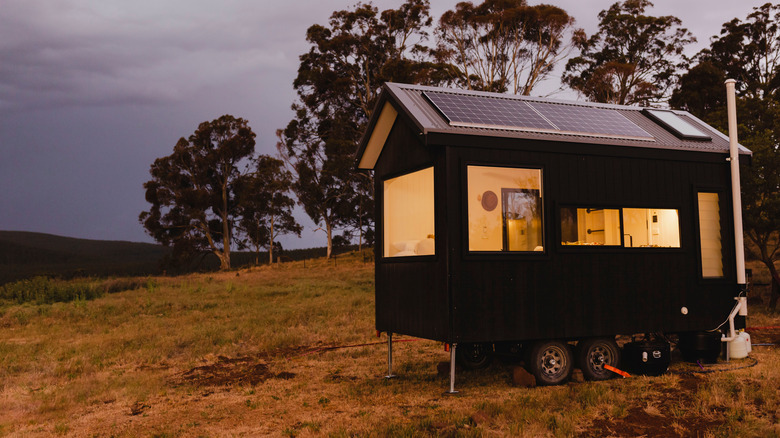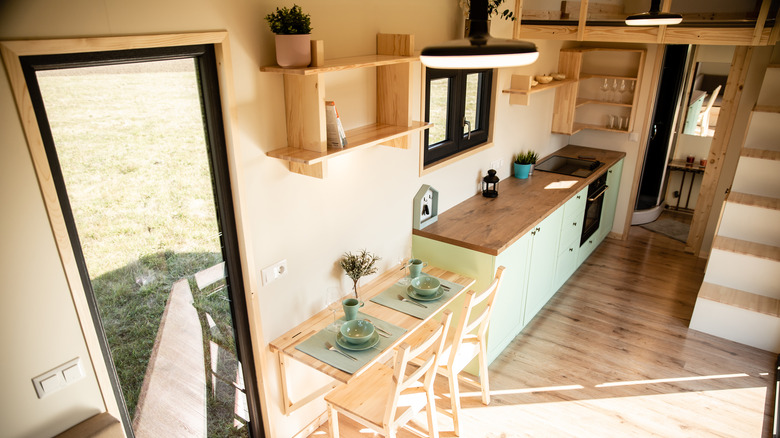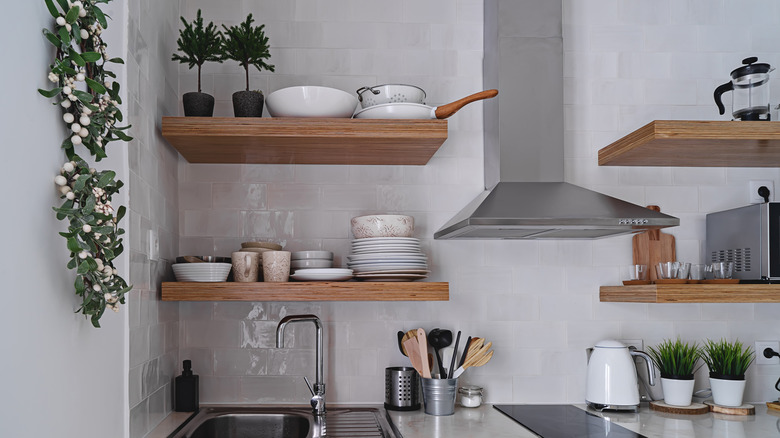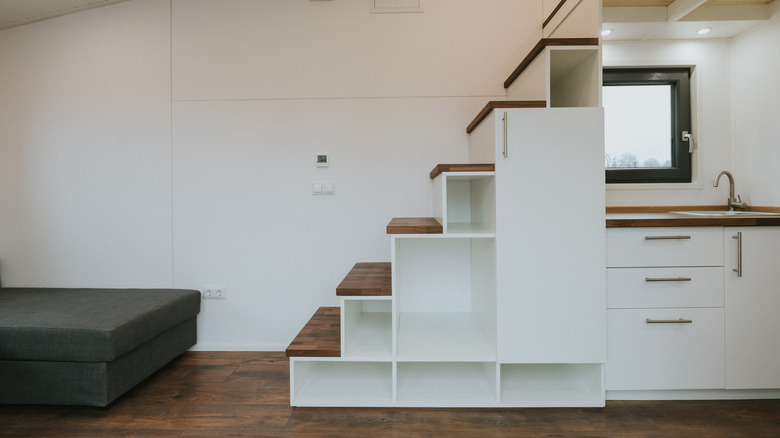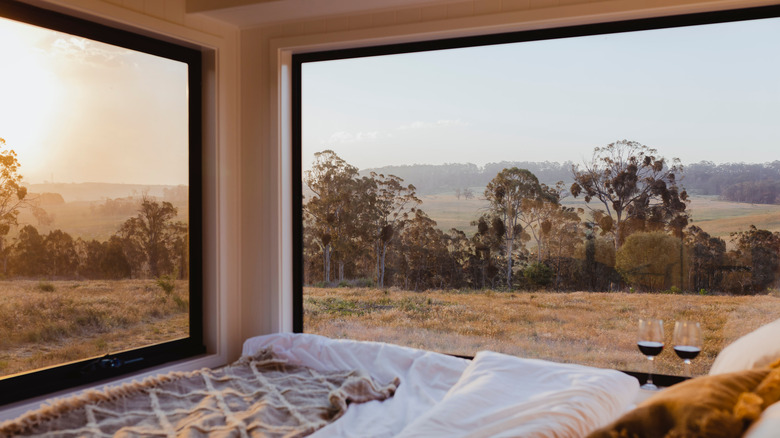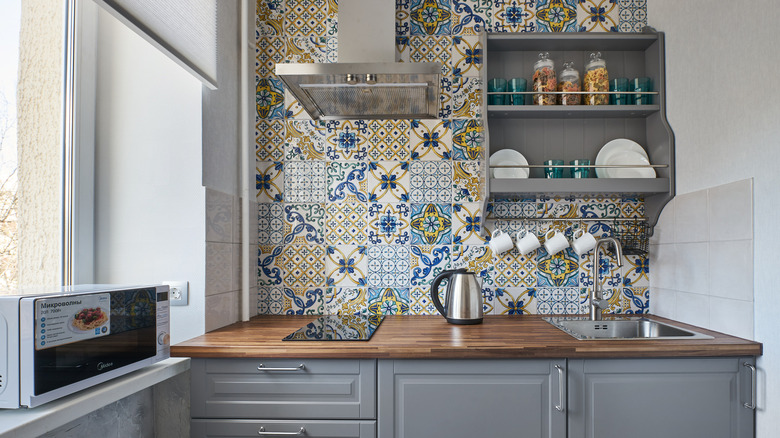5 Tips For Decorating Your Tiny House Like A Pro
The tiny house movement is all about simplifying life by downsizing on material items and lowering people's environmental impact by using little to no utilities. Another large reason many people choose to purchase or build their own tiny house is that it is more affordable than a mortgage for a typical home, according to Tiny Home Builders. The initial cost of a tiny house is cheaper than a standard-sized home, as well as the cost of utilities if the home is not off the grid.
To be considered a tiny house, a home needs to be less than 600 square feet. It can be built on a foundation or on a trailer. Since these homes are so tiny, every piece of furniture, decor and all personal items need to be carefully chosen. Decorating a tiny home can be difficult because of the limited amount of space, but there are ways to decorate and make the home appear larger than it is.
1. Light color palette
The color palette you choose can change the look of the entire house. Since tiny houses are so small, it's important to create the illusion of space whenever possible. Even the colors you paint the walls can make your home feel bigger. To do this, you will want to choose a light color palette. Tiny House Giant Journey recommends choosing an off-white color that fits in with your personal decor style. You don't have to paint your walls stark white, to keep the space feeling homey, opt for neutral colors like gray, stone, or sand.
Sticking to one color palette and using it throughout the home is another way to keep a tiny house feeling larger than it is and cohesive. This is because adding too many different colors and textures to a room makes it feel busy and cluttered since your eyes don't know what to focus on. You can prevent this by adding only pops of color as accents to compliment the neutral-colored walls.
2. Think vertically
Decorating a tiny home can be difficult because you don't want it to feel cluttered with decor pieces that don't have a purpose. Instead of filling up coffee tables and valuable kitchen counter space with decor, think vertically. Space Wise recommends maximizing your wall space, which can be done by decorating with floating shelves to put your knick-knacks on, using decorative hooks to hang things on, and hanging frames.
The idea of using all the vertical space in a tiny home is to draw the eye up to the ceiling. This will create the illusion of more height than there is and more space in the tiny home. Putting plants in hanging pots and on shelves is another way to utilize wall space while adding more life to the home. In the kitchen, floating shelves can be used in place of cabinets for a more open feel. TVs can also be mounted on the wall to save floor space as well as wall desks.
3. Multi-functional pieces
In such a small space, every piece of furniture and decor needs to have a purpose, and it is even better when they have multiple functions. Multi-functional pieces can be used throughout a tiny house, and often their second function is to provide more storage space. In tiny homes that have a loft space, the staircase can also include built-in closets, drawers, or bookshelves. A built-in like this doubles as a space to display decor on the shelves and also store clothes or kitchen items in a closed storage space. This way, the empty space under the stairs is put to use.
Another multi-functional piece that Love to Know suggests for tiny homes are built-in benches with hidden storage space inside them. These benches can be used in place of a couch in the living room area or as seating for a breakfast nook. The upholstery can be customized to fit your decor style and the color palette of the tiny home. Then when you lift up the seat cushions, there will be hidden storage space for extra bedding, out-of-season clothes, or anything else you wouldn't need to access regularly.
4. Lots of natural light
Utilizing all the natural light available can open up the space in a tiny home. The more light in the room, the brighter it will be and the larger the room will appear. To allow in as much natural light as possible in a tiny home, don't block the windows with furniture and use sheer curtains rather than blackout curtains. That way, even when your curtains are pulled closed, light is able to come in. Love to Know suggests installing skylights since they won't take up any wall space you could use for decor.
Strategically hanging mirrors will add more light to a tiny home. When mirrors are hung opposite from windows, the natural light will bounce off the mirror and add more light to the room. If your tiny home doesn't have a lot of natural light, your next best bet is using warm light bulbs. As long as the tiny home is well lit, it will appear more open than it is.
5. Separate with rugs and tiles
Tiny homes are often one large living area, like studio apartments, that need creative ways to separate the space. Adding walls to a tiny home will only make it feel even smaller, so walls are only used where necessary. One way to create rooms in a tiny home is by using rugs. You don't need to add a ton of different rugs all over your tiny home for this to work, and the rug doesn't have to take up the entire space. Home Scopes explains that rugs can section off rooms by creating contrast between different areas in the tiny home. Rugs are a great choice to do this because they take up very little space.
Another way to section off a space and add a design is with tiles. This can be done in the kitchen area by installing patterned tiles or in bathrooms. A pop of color in the tiles will add to the design of the home and separate the space from the rest of the home.
